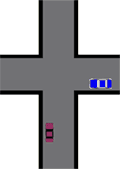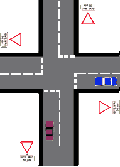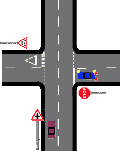 Crossroads
Crossroads
 Crossroads
Crossroads
Crossroads
Before learning about crossroads you will have learnt to deal with approaching and emerging from junctions to turn left and right. In this tutorial you will be introduced to some of the different types of crossroads that you will encounter and see what makes them more complex than T junctions.
Crossroads can be accident black spots and extra care must be taken where the traffic is fast moving or vehicles will be turning right.
When you arrive at any crossroad you will have the choice of turning left, right or going straight ahead. How you deal with them will depend on whether they are controlled or uncontrolled.
Types of Crossroads.
Uncontrolled Crossroads. 


When you approach any crossroad you must be looking for any indication of which is the priority road , in this picture you can see that there are no signs or markings indicating any priority which is why these are often referred to as unmarked crossroads.
These crossroads must be approached with extreme caution, you must make effective observations and only make a manoeuvre when you are absolutely sure that it is safe to do so.



It is a good rule of thumb to approach an unmarked crossroad as if there were give way signs or markings showing against you and deal with it accordingly.
Controlled Crossroads
Crossroads can be controlled in a variety of ways:
 This is a picture of a crossroads controlled by traffic lights - when you approach this type of crossroad it is still important to make the normal observations.
This is a picture of a crossroads controlled by traffic lights - when you approach this type of crossroad it is still important to make the normal observations.
Even if the traffic lights in your direction of travel are showing green (remember that a green light does not just mean "go" - it means "proceed if it is safe to do so"), you must still check that no vehicles are emerging from the left or right and be aware that emergency vehicles may be approaching.
You might occasionally come across a traffic light controlled crossroads where the lights are not working - in this case you must exercise great caution and treat it as if it were an uncontrolled crossroads.
 Crossroads can also be controlled by roundabouts - there are special rules relating to roundabouts which will be covered in the roundabout tutorial.
Crossroads can also be controlled by roundabouts - there are special rules relating to roundabouts which will be covered in the roundabout tutorial.
 And they can be controlled by road signs and markings - this type of crossroad is commonly referred to as a "marked crossroad" and it is marked crossroads that we will be concentrating on in this tutorial.
And they can be controlled by road signs and markings - this type of crossroad is commonly referred to as a "marked crossroad" and it is marked crossroads that we will be concentrating on in this tutorial.
You should by now becoming familiar with using the MSM routine on the approach to hazards - let's remind ourselves of the routine and see how to apply it on the approach to some marked crossroads.
Note: When you go to the next page you'll have to scroll the page back to the top!![]()
Look, Assess & Decide
One of the reasons for slowing down is to give us enough time to make effective observations. When we reach a point from which we can see we need to look:
Right - Ahead - Left - Ahead and then Right again - and then continue looking until we make the manoeuvre.
Left/Right - when we look left and right we should have a clear uninterrupted view along the road to enable us to act sensibly and we would not emerge if we would make any traffic approaching from the right to slow down or change direction.
Ahead - this means looking at any traffic on the road ahead in particular for traffic that may be intending turning right and crossing our path. You have priority over these vehicles but cannot assume that they will give way to us.
Final Checks - Now is the time to check the mirrors again - check:
The interior mirror so that you are aware of what is happening behind.
The exterior mirror for any cyclists that may be coming alongside in the case of a left turn and for any traffic that may have come up on the offside if we are going to turn right.
And look into the new road for any pedestrians who may be crossing - we must give way to them.
Now would you like to run through that again or see how we would apply the MSM to another situation.
Speed
Now we need to consider the speed of approach.
Apply the brakes progressively to so we can make effective observations and allow us to stop if necessary.
If you are in the correct gear you will not have to use the clutch unless you have to stop.
If you do need to change gear remember to complete the gear change - if the clutch is left pushed in it will cause the car to coast and will affect the speed we intend for our approach.
Position
When approaching crossroads the position for a left turn will be the normal driving position (obstructions permitting).
For a right turn position towards the centre of the road as if you were turning right at a junction.
If you intend going straight ahead, first check for any markings on the road for guidance and if there are none position yourself in the normal driving position.
Signal
ln this example the driver will be going straight ahead so no signal is necessary - when would the signal have been made if the driver was planning to turn left at the crossroads ahead?
Mirrors
The driver has noticed the warning sign and if he was not already aware of the approaching crossroads he has now had advanced warning and will begin his MSM routine.
Initial checks in the interior mirror and left or right exterior mirror depending on the intended direction of the manoeuvre.